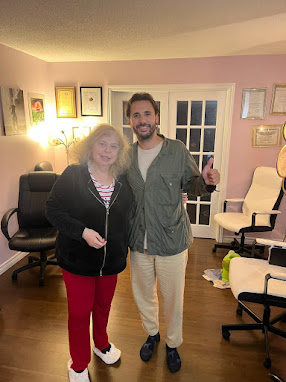What does it take to learn how to sing well?
In the conventional sense, it seems
not so difficult to learn how to sing. People do some scales, some lip-trills,
as well as:
After doing the above for years,
the potential singers are assured that sometime, (perhaps, in the year 2050.
lol), or soon thereafter, they will suddenly wake up with a “big voice” and that
will assure their singing career for more years ahead, (if, by that time, they
will have any years of their actual lives left).
Perhaps due to their age then, they
could be good for a senior citizens choir or, for that matter; they can even become
the worst Opera Singer, (as
seen in this video). Who knows?
Meanwhile, jokes aside, the time is passing by; the person gets older and still cannot apply any of the above aforementioned exercises to the real singing. So what’s wrong with that picture?
On this note, please view the video of our former voice repair client, Opera Singer from Essex UK, Evie Bonella; compare the two and tell us if you hear that the Vocal Science technique helped in the latter performance.
Meanwhile, jokes aside, the time is passing by; the person gets older and still cannot apply any of the above aforementioned exercises to the real singing. So what’s wrong with that picture?
On this note, please view the video of our former voice repair client, Opera Singer from Essex UK, Evie Bonella; compare the two and tell us if you hear that the Vocal Science technique helped in the latter performance.
The answer is that those nonsensical
vocal exercises are simply not applicable to any real singing, but rather destructive
and dangerous to the vocal anatomy. They are drying out the throat, wearing out
the vocal cords and disturbing the larynx by moving them up and down. Meanwhile,
any song consists of certain combinations of sounds, duration and pitch, i.e.
intervals. The vocal
exercises are supposed to consist of those various combinations.
Once the singer learns how to
approach those intervals,
he/she will begin to learn the certain situations where those combinations of
sound, duration and pitch will and may exist.
There are only so many combinations
and only so many situations where they could exist. Once you become a master of
that formula, you become the owner and master of your voice.
You also become mentally sound, as during
those vocal exercises, they alignment of the subconscious and conscious mind is
achieved. The upper abdomen is strengthened,
as it plays the crucial role of the support of the sound, lifted and
restructured (via
the aforementioned speech and vocal exercises), off of the vocal box and
off of the vocal cords to the set of the facial muscles and away from the vocal
anatomy.
Now the safety net and the
invisible mending, so to speak, are built and the danger of damaging the voice
and the actual vocal box is eliminated. The flora of the throat is now clean,
as natural herbal remedies were applied to eliminate the impurities, such as mucus
and gastric acid.
The “instrument” is ready to be “played
on”.
The “player” has all his “mental
pages” (figuratively speaking), indexed via applicable voice/vocal
exercises. So there is nothing that will prevent the person from singing
well and from getting better for years to come.


